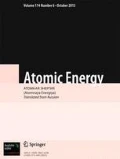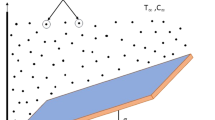When fuel rods melt during a severe accident, the movement of the structural and fuel materials along fuel assemblies can be spatially non-uniform, so that a three-dimensional thermohydraulic model is implemented in the EVKLID/V2 code as part of the HYDRA-IBRAE/LM module. The transport of the same sets of components and their mixtures as in the one-dimensional version of the HYDRA-IBRAE/LM module can be calculated in the model: liquid sodium, sodium vapor or vapor-gas mixture of sodium vapor and non-condensable gases, solid lead, liquid lead, solid uranium dioxide, liquid uranium dioxide, hard stainless steel, liquid stainless steel, steel vapor. The three-dimensional model is implemented in a cylindrical coordinate system, which makes it easier to include the geometric dimensions and parameters of a particular fuel assembly (number and diameter of fuel rods, lattice pitch, and others) and the core. A description is given of the basic system of equations describing the motion of the components of the destroyed core in the three-dimensional r–z–φ geometry, and its numerical realization. Examples of test calculations showing the serviceability of the model are presented.
Similar content being viewed by others
References
N. A. Mosunova, “Integrated code EUCLID/V1 to justify the safety of fast-neutron reactor installations with a liquid metal coolant. Part 1: Basic models,” Teploenergetika, No. 5, 69–84 (2018).
E. V. Usov, A. A. Butov, V. I. Chukhno, et al., “Fuel pin melting in a fast reactor and melt solidification: simulation using the SAFR/V1 module of the EVKLID/V2 integral code,” At. Energ., 124, No. 3, 1–7 (2018).
E. V. Usov, A. A. Butov, V. I. Chukhno, et al., “SAFR / V1 (EVKLID / V2 integral code module) aided simulation of melt movement along the surface of a fuel element in a fast reactor during a serious accident,” At. Energ., 124, No. 4, 1–7 (2018).
A. A. Butov, V. S. Zhdanov, I. A. Klimonov, et al., “Physical models for calculating the destruction of a fuel rod and the core of a reactor with liquid metal coolant, implemented in the EUCLID / V2 code,” Teploenergetika, No. 5, 5–15 (2019).
A. Flores, V. Matuzas, S. Perez-Martin, et al., “Analysis of ASTEC-Na capabilities for simulating a loss of flow CABRI experiment,” An. Nucl. Energy, 94, 175–188 (2016).
E. Bubelis, A. Tosello, W. Pfrang, et al., “System codes benchmarking on a low sodium void effect SFR heterogeneous core under ULOF conditions,” Nucl. Eng. Des., 320, 325–345 (2017).
S. Wahnona, L. Ammirabile, J. Kloosterman, and D. Lathouwers, “Multi-physics models for design basis accident analysis of sodium fast reactors. Part I. Validation of three-dimensional TRACE thermal-hydraulics model using Phenix end-of-life experiments,” Nucl. Eng. Des., 331, 331–341 (2018).
R. Kruessman, A. Ponomarev, W. Pfrang, et al. “Assessment of SFR reactor safety issues. Part II. Analysis results of ULOF transients imposed on a variety of different innovative core designs with SAS-SFR,” Nucl. Eng. Des., 285, 263–283 (2015).
D. David, P. Rao, B. Nashine, and P. Selvaraj, “Numerical investigation of turbulent natural convection in the lower plenum of sodium cooled fast reactor under core relocation scenario,” Nucl. Eng. Des., 322, 277–290 (2017).
M. Raj, K. Velusamy, and R. Maity, “Thermal hydraulic investigations on porous blockage in a prototype sodium cooled fast reactor fuel pin bundle,” Nucl. Eng. Des., 303, 88–108 (2016).
S. Mimouni, M. Guinjo, and J. Lavieville, “Assessment of RANS at low Prandtl number and simulation of sodium boiling flows with a CMFD code,” Nucl. Eng. Des., 312, 294– 302 (2017).
S. Manservisi and F. Menghini,” Nucl. Eng. Des., 273, 251–270 (2014).
A. Papukchiev and S. Buchholz, “Validation of ANSYS CFX for gas and liquid metal flows with conjugate heat transfer within the European project THINS,” Nucl. Eng. Des., 312, 338–350 (2017).
Yu. M. Ashurko, A. V. Volkov, and K. F. Raskach, “Development of software modules for calculating beyond design basis accidents in fast reactors taking into account spatio-temporal kinetics,” At. Energ., 114, No. 2, 63–67 (2013).
H. Yamano, Y. Tobita, and S. A. Fujita, “Three-dimensional neutronics-thermohydraulics simulation of core disruptive accident in sodium-cooled fast reactor,” Nucl. Eng. Des., 239, No. 9, 1673–1681 (2009).
V. M. Alipchenkov, Y. A. Zeigarnik, N. A. Mosunova, et al., “Fundamentals, current state of the development of, and prospects for further improvement of the new generation thermal hydraulic computational HYDRA-IBRAE/LM code for simulation of fast reactor systems,” Thermal Eng., 63, No. 2, 130–139 (2016).
R. Clift and W. Gauvin, “Motion of entrained particles gas streams,” Can. J. Chemical Eng., 49, No. 4, 439–448 (1971).
F. Creit and W. Black, Fundamentals of Heat Transfer [Russian translation], Mir, Moscow (1983).
S. Whitaker, “Forced convection heat transfer correlations for flow in pipes, past flat plates, single cylinders, single spheres, and for flow in packed beds and tube bundles,” AIChE J., 18, 361–371 (1972).
E. V. Usov., A. A. Butov, V. I. Chukhno, et al., “Features of the EUCLID/V2 code algorithms for mathematical modeling of melt motion during a severe accident in a fast reactor,” Vopr. At. Nauki Tekhn. Ser. Mat. Model. Fiz. Prots., No. 1, 69–77 (2019).
R. A. Irkimbekov, Energy Release in a Model Fuel Assembly during Thermal Tests in a Pulsed Reactor Installation: Cand. Dissert. in Phys. Math. Sci., Tomsk (2016).
Author information
Authors and Affiliations
Corresponding author
Additional information
Translated from Atomnaya Énergiya, Vol. 127, No. 1, pp. 3–8, July, 2019.
Rights and permissions
About this article
Cite this article
Usov, E.V., Butov, A.A., Chukhno, V.I. et al. 3D EVKLID/V2 Code Aided Simulation of Severe Accidents. At Energy 127, 1–7 (2019). https://doi.org/10.1007/s10512-019-00575-5
Received:
Published:
Issue Date:
DOI: https://doi.org/10.1007/s10512-019-00575-5




